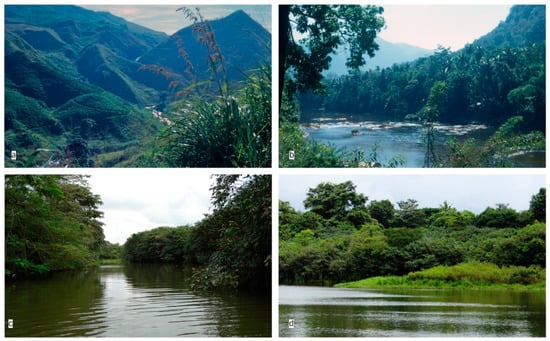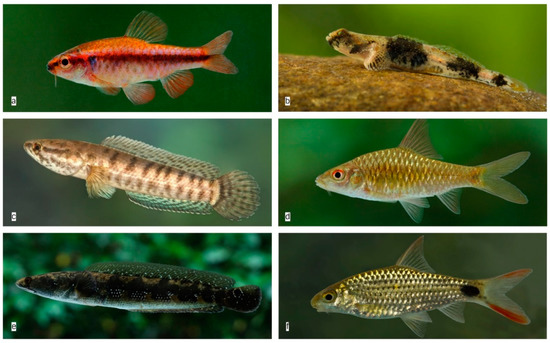Kelani River is an ecosystem complex comprising a wide spectrum of habitats, ranging from mountain springs and ephemeral headwater streams to large perennial rivers as well as a diverse array of inland and coastal wetlands (Figure 5). Meandering through three major floristic regions—northern wet lowlands, foothills of Adam’s Peak and Ambagamuwa, and the Adam Peak highlands—the Kelani River associates three diversity rich forest communities: tropical wet evergreens, tropical moist upper montane forests, and tropical submontane evergreens [76]. A critically endangered, narrow-range endemic woody species, Balanocarpus kitulgalensis is restricted to riparian forests of the Kelani basin [9]. The Kelani is also known for hosting narrow-range endemic invertebrates, including three species of critically endangered freshwater crabs. In addition, 16 and 23 nationally threatened dragonfly and butterfly species respectively, occur in the basin [21]. A total of 73 nationally threatened non-fish vertebrates (nine amphibians, 11 reptiles, 25 birds, and 28 mammals) are also associated with the basin [77].
Freshwater Fish Diversity in Kelani River Basin and Threats Encountered by Fish Communities
Scientifically informed conservation planning should identify and provide protection to native aquatic biodiversity, particularly freshwater fish. Thus, reviewing the diversity and distribution of freshwater fish is critical. Kelani River basin is nested within the southwestern ichthyological province of Sri Lanka where more than half of Sri Lanka’s endemic freshwater fish occur [42,77]. Here, combining literature review and authors’ personal observations, we documented a total of 60 freshwater fish species in the Kelani basin, of which 30 are endemic (Table 3, Figure 6). This fish community accounts for 63% Sri Lankan freshwater fish diversity and represents 17 families. Among the fish community of the Kelani, 22 species are threatened (six Critically Endangered; 13 Endangered; three Vulnerable) [17].
Table 3. The list of indigenous freshwater fish species recorded in the Kelani River basin, Sri Lanka.
|
Family |
Species |
Common Name |
National Conservation Status |
Information Source |
|
Cyprinidae |
Amblypharyngodon grandisquamis (SLE) |
Silver Carplet |
LC |
FOA/MUR |
|
Cyprinidae |
Dawkinsia singhala (SLE) |
Sri Lankan Filamented Barb |
LC |
FOA/MUR |
|
Cyprinidae |
Devario malabaricus (NTV) |
Giant Danio |
LC |
FOA/MUR |
|
Cyprinidae |
Devario micronema (SLE) |
|
- |
FOA/MUR |
|
Cyprinidae |
Esomus thermoicos (NTV) |
Sri Lankan Flying Barb |
LC |
FOA/MUR |
|
Cyprinidae |
Garra ceylonensis (SLE) |
Sri Lankan Stone Sucker |
VU |
FOA/MUR |
|
Cyprinidae |
Horadandia atukorali (SLE) |
Horadandia |
VU |
FOA |
|
Cyprinidae |
Labeo heladiva (SLE) |
Common Labeo |
LC |
FOA |
|
Cyprinidae |
Laubuka varuna (SLE) |
Varuna Laubuka |
CR |
FOA/MUR |
|
Cyprinidae |
Pethia bandula (SLE) |
Bandula Barb |
CR |
FOA/MUR |
|
Cyprinidae |
Pethia nigrofasciata (SLE) |
Black Ruby Barb |
EN |
FOA/MUR |
|
Cyprinidae |
Pethia reval (SLE) |
Red-finned Barb |
EN |
FOA/MUR |
|
Cyprinidae |
Puntius bimaculatus (NTV) |
Red Side Barb |
LC |
FOA/MUR |
|
Cyprinidae |
Puntius dorsalis (NTV) |
Long Snouted Barb |
LC |
FOA/MUR |
|
Cyprinidae |
Puntius kamalika (SLE) |
Kamalika’s Barb |
EN |
FOA/MUR |
|
Cyprinidae |
Puntius kelumi (SLE) |
Kelum’s Barb |
EN |
FOA/MUR |
|
Cyprinidae |
Puntius chola (NTV) |
Swamp Barb |
LC |
FOA/MUR |
|
Cyprinidae |
Puntius titteya (SLE) |
Cherry Barb |
EN |
FOA/MUR |
|
Cyprinidae |
Puntius vittatus (NTV) |
Silver Barb |
LC |
FOA/MUR |
|
Cyprinidae |
Rasbora dandia (NTV) |
Broad-lined Striped Rasbora |
LC |
FOA/MUR |
|
|
Rasbora microcephalus (NTV) |
Narrow-lined Striped Rasbora |
LC |
FOA/MUR |
|
Cyprinidae |
Rasboroides vaterifloris (SLE) |
Fire Rasbora |
- |
FOA |
|
Cyprinidae |
Systomus pleurotaenia (SLE) |
Black Lined Barb |
EN |
FOA/MUR |
|
Cyprinidae |
Systomus asoka (SLE) |
Asoka Barb |
CR |
FOA/MUR |
|
Cyprinidae |
Systomus sarana (NTV) |
Olive Barb |
LC |
FOA/MUR |
|
Cyprinidae |
Tor khudree (NTV) |
Mahseer |
NT |
FOA/MUR |
|
Cobitidae |
Lepidocephalichthys thermalis (NTV) |
Common Spiny Loach |
LC |
FOA/MUR |
|
Nemacheilidae |
Paracanthocobitis urophthalma (SLE) |
Tiger Loach |
EN |
FOA/MUR |
|
Nemacheilidae |
Schistura notostigma (SLE) |
Banded Mountain Loach |
NT |
FOA/MUR |
|
Bagridae |
Mystus gulio (NTV) |
Long Whiskered Catfish |
LC |
FOA |
|
Bagridae |
Mystus nanus (SLE) |
Sri Lankan Dwarfed Striped Catfish |
LC |
FOA/MUR [78] |
|
Bagridae |
Mystus ankutta (SLE) |
Sri Lankan Dwarf Catfish |
EN |
FOA/MUR |
|
Bagridae |
Mystus zeylanicus (SLE) |
Sri Lankan Yellow Catfish |
LC |
FOA/MUR |
|
Siluridae |
Ompok argestes (SLE) |
Sri Lankan Mottled Butter Catfish |
DD |
FOA/MUR [79] |
|
Siluridae |
Wallago attu (NTV) |
Silver Shark |
EN |
FOA |
|
Clariidae |
Clarias brachysoma (SLE) |
Walking Catfish |
NT |
FOA/MUR |
|
Heteropneustidae |
Heteropneustes fossilis (NTV) |
Stinging Catfish |
LC |
FOA |
|
Aplocheilidae |
Aplocheilus dayi (SLE) |
Day’s Killifish |
EN |
FOA/MUR |
|
Aplocheilidae |
Aplocheilus parvus (NTV) |
Dwarf Killifish |
LC |
FOA |
|
Cichlidae |
Etroplus suratensis (NTV) |
Green Chromide |
LC |
FOA |
|
Cichlidae |
Pseudetroplus maculatus (NTV) |
Yellow Chromide |
LC |
FOA |
|
Gobiidae |
Awaous melanocephalus (NTV) |
Scribbled Goby |
LC |
FOA |
|
Gobiidae |
Glossogobius giuris (NTV) |
Bar Eyed Goby |
LC |
FOA |
|
Gobiidae |
Schismatogobius deraniyagalai (NTV) |
Red Neck Goby |
EN |
FOA |
|
Gobiidae |
Sicyopterus griseus (NTV) |
Stone Goby |
CR |
FOA/MUR |
|
Gobiidae |
Sicyopus jonklaasi (SLE) |
Lipstick Goby |
EN |
FOA |
|
Anguillidae |
Anguilla bicolor (NTV) |
Level Finned Eel |
LC |
FOA |
|
Anguillidae |
Anguilla nebulosa (NTV) |
Long Finned Eel |
LC |
FOA |
|
Anabantidae |
Anabas testudineus (NTV) |
Climbing Perch |
LC |
FOA |
|
Synbranchidae |
Monopterus desilvai (SLE) |
Sri Lankan Lesser Swamp Eel |
CR |
FOA |
|
Synbranchidae |
Ophisternon bengalense (NTV) |
Asian Swamp Eel |
CR |
MUR |
|
Osphronemidae |
Belontia signata (SLE) |
Combtail |
NT |
FOA/MUR |
|
Osphronemidae |
Pseudosphromenus cupanus (NTV) |
Spike Tailed Paradisfish |
LC |
FOA/MUR |
|
Channidae |
Channa ara (SLE) |
Sri Lankan Giant Snakehead |
EN |
FOA |
|
Channidae |
Channa gachua (SLE) |
Brown Snakehead |
LC |
FOA |
|
Channidae |
Channa orientalis (SLE) |
Smooth Breasted Snakehead |
VU |
FOA |
|
Channidae |
Channa punctata (NTV) |
Spotted Snakehead |
LC |
FOA |
|
Channidae |
Channa striata (NTV) |
Murrel |
LC |
FOA |
|
Mastacembelidae |
Mastacembelus armatus (NTV) |
Marbled Spiny Eel |
LC |
FOA/MUR |
|
Belonidae |
Xenentodon cancila (NTV) |
Freshwater Garfish |
NT |
FOA |
Abbreviations: SLE—Endemic to Sri Lanka; NTV—Native; CR—Critically Endangered; EN—Endangered; VU—Vulnerable; LC—Least Concerned; NT—Near Threatened; DD—Data Deficient; FOA—Field observation by Authors; MUR—Museum records.
Among the freshwater fishes of Kelani River basin, two are microendemics: Pethia bandula (Bandula barb) and Systomus asoka (Asoka barb, Figure 5). The former is restricted to a narrow stretch of single tributary (at Galapitamada, Kegalle district) in the middle reaches of the basin; the latter have been documented in several tributaries of the Kelani river in the foothills (Kithulgala and Deraniyagala, Kegalle District) [32,80]. The two species of Synbranchid eels (swamp eels), Monopterus desilvai (Lesser swamp eel) and Ophisternon bengalense (Asian Swamp eel) are found in the coastal swamps hydrologically connected to the lower reaches of Kelani River. Filling such wetlands threatens these eels.

Figure 5. Habitats in different reaches of the Kelani River: (a) headwaters of central highlands (Duncan Campbell and Douglas Campbell); (b) mid-reaches, with forested riparian zone (Joanne Goldby); (c) inland wetland habitats; (d) coastal wetland complex at Beddagana Wetland Park (Kassapa Jayasinghe, Madhava Botejue).
Fish species specialized for highly-oxygenated fast-flowing cold waters such as Garra ceylonensis (Ceylon stonesucker), Systomus pleurotaenia (Black lined barb), and Schistura notostigma (Banded mountain loach) cannot tolerate hydrological modifications such as channelization, impoundments, and pollution [62]. Pethia nigrofasciata (Black ruby barb) prefers canopy-shaded streams and are unlikely to persist where riparian forest is lost. Due to industrial and domestic waste discharge in lower reaches, occasional fish kills have been reported in the last few decades [57]. Streambed siltation stemming from watershed-scale deforestation may degrade and destroy nesting and spawning grounds. Puntius titteya (Cherry barb, Figure 5), an endemic fish found in shady, slow-flowing streams, still occurs even in the suburbs of Colombo [81]. However, its habitats are being degraded and is becoming increasingly uncommon.
Several cyprinid species of the Kelani River migrate upstream for breeding during the monsoon season; impoundments may interrupt their life cycles and negatively impact recruitment [10]. Diadromous fish of Kelani River, such as sicydiine gobies Sicyopus jonklaasi (Lipstick goby) and Sicyopterus griseus (Stone goby) spend their adult stages in freshwater: they spawn in freshwater but their larvae migrate to saltwater for growth and maturation [82]. Continuity of their life cycle depends on unimpeded river passage, presence of natural riparian vegetation cover, unmodified flow regimes, low silt load, high-quality estuarine habitats, and absence of introduced species [82].
Schismatogobius deraniyagalai (Redneck Goby, Figure 5), a goby restricted to open, clear, shallow waters with a sandy substrate (HS, personal observations) is vulnerable to impaired water quality and sand mining along the river. At least 25 species of alien freshwater fish are established in Sri Lanka, exerting pressure on native freshwater biodiversity, and the Kelani River is no exception [83]. This basin, particularly its urban and residential reaches, hosts several alien fish species including Clarias batrachus (Walking catfish), Chitala ornata (Clown featherback), Pterygoplichthys cf. disjunctivus (Vermiculated Sailfin Catfish), Poecilia reticulata (Guppy), Oreochormis mossambicus (Mozambique Tilapia), O. niloticus (Nile Tilapia), Trichopodus pectoralis (Snakeskin gourami), T. trichopterus (Three-spot gourami), and Helostoma temminkii (Kissing gourami) [20,84–86]. Moreover, other aquatic exotic invaders—Trachemys scripta (Red-eared slider, a turtle) and Pomacea diffusa (Apple snail) in particular—have been documented along the lower reaches of the river (HS, personal observations). These alien species compete with native fishes for critical resources such as food, habitats, and nesting grounds (Oreochromis species) [22]. Predatory alien fish (Clarias batrachus and Chitala ornata) prey on small-sized native fish, while Poecilia reticulata feeds on native amphibian eggs [85]. These exotic species can change habitat structure and ecological processes, rendering habitats unsuitable for native freshwater biota. For instance, the invasive catfish Pterygoplichthys cf. disjunctivus burrows nests in the river banks and induces bank erosion and instability; this catfish is also known to alter benthic habitat structure, reduce availability of benthic resources, and modify nutrient dynamics [87]. Macrognathus pentophthalmos (Lesser Spiny Eel), a species now extremely rare in Sri Lanka, used to be once common in the lowland flood plains of Kelani River basin such as at Hanwella, where it had been harvested in the fishery [88]. The combination of several factors, such as invasive predatory species and pollutants, is likely responsible for the rarity of this species at present. Certain aquatic invasive plants (water hyacinth, Eichhornia crassipes) increase sediment retention and organic-matter accumulation in water, impairing water clarity and dissolved oxygen levels while increasing evaporation rates [85]. Many urban wetlands (Figure 6) of Kelani River basin, particularly those located in metropolitan Colombo, have been prolifically invaded by alien aquatic plants, rendering dramatic changes in habitat structure and wetland hydroperiod [86].

Figure 6. Native freshwater fish species found in Kelani River basin (a) Puntius titteya; (b) Schismatogobius deraniyagalai; (c) Channa punctata; (d) Puntius kelumi; (e) Channa ara; (f) Systomus asoka (Mahesh De Silva, Hiranya Sudasinghe, Sameera Akmeemana, Krishan Wewalwala).
This entry is adapted from the peer-reviewed paper 10.3390/w12010026
 Encyclopedia
Encyclopedia
